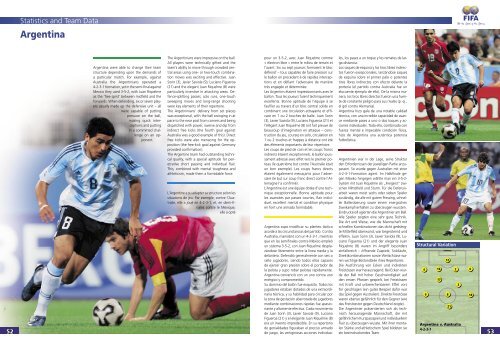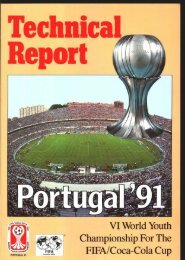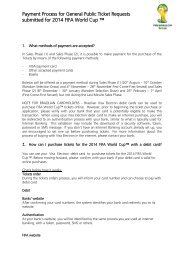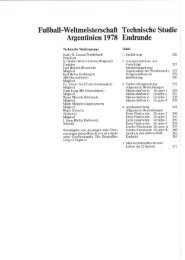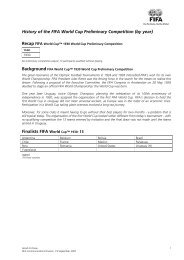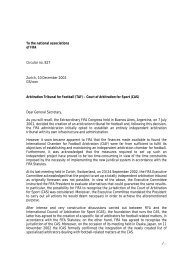Create successful ePaper yourself
Turn your PDF publications into a flip-book with our unique Google optimized e-Paper software.
Statistics and Team Data<br />
Argentina<br />
Argentina were able to change their team<br />
structure depending upon the demands of<br />
a particular match. For example, against<br />
Australia the Argentinians operated a<br />
4-2-3-1 formation, yet in the semi-fi nal against<br />
Mexico they used 3-5-2, with Juan Riquelme<br />
as the ‘free spirit’ between midfi eld and the<br />
forwards. When defending, six or seven players<br />
usually made up the defensive unit – all<br />
were capable of putting<br />
pressure on the ball,<br />
making quick interceptions<br />
and putting<br />
in a <strong>com</strong>mitted challenge<br />
on an opponent.<br />
The Argentinians were impressive on the ball.<br />
All players were technically gifted and the<br />
team’s ability to move through crowded central<br />
areas using one- or two-touch <strong>com</strong>bination<br />
moves was exciting and effective. Juan<br />
Sorin (3), Javier Saviola (9), Luciano Figueroa<br />
(21) and the elegant Juan Riquelme (8) were<br />
particularly inventive in attacking areas. Defence-splitting<br />
passes, solo runs, one-touch<br />
sweeping moves and long-range shooting<br />
were key elements of their repertoire.<br />
The Argetininians’ delivery from set pieces<br />
was exceptional, with the ball swinging in at<br />
pace to the near post from corners and being<br />
dispatched with power, swerve and dip from<br />
indirect free kicks (the fourth goal against<br />
Australia was a good example of this). Direct<br />
free kicks were also menacing for the opposition<br />
(the free-kick goal against <strong>Germany</strong><br />
provided confi rmation).<br />
The Argentine team had outstanding technical<br />
quality, with a special aptitude for penetrative<br />
short passing and individual fl air.<br />
This, <strong>com</strong>bined with mental toughness and<br />
athleticism, made them a formidable force.<br />
L’Argentine a su adapter sa structure selon les<br />
situations de jeu. Par exemple, contre l’Australie,<br />
elle a joué en 4-2-3-1, et, en demi-fi -<br />
nales contre le Mexique,<br />
elle a opté<br />
pour un 3-5-2, avec Juan Riquelme <strong>com</strong>me<br />
« électron libre » entre le milieu de terrain et<br />
l’avant. Six ou sept joueurs formaient le bloc<br />
défensif – tous capables de faire pression sur<br />
le ballon en procédant à de rapides interceptions<br />
et en défi ant l’adversaire de manière<br />
très engagée et déterminée.<br />
Les Argentins étaient impressionnants avec le<br />
ballon. Tous les joueurs furent techniquement<br />
excellents. Bonne aptitude de l’équipe à se<br />
faufi ler au travers d’un bloc central solide en<br />
<strong>com</strong>binant une circulation attrayante et effi -<br />
cace en 1 ou 2 touches de balle. Juan Sorin<br />
(3), Javier Saviola (9), Luciano Figueroa (21) et<br />
l’élégant Juan Riquelme (8) ont fait preuve de<br />
beaucoup d’imagination en attaque – construction<br />
du jeu, courses en solo, circulation en<br />
1 ou 2 touches et frappes à distance ont été<br />
des éléments importants de leur répertoire.<br />
Les coups de pied de coin et les coups francs<br />
indirects étaient exceptionnels, le ballon puissament<br />
adressé avec effet vers le premier poteau<br />
(le quatrième but contre l’Australie était<br />
un bon exemple). Les coups francs directs<br />
étaient également menaçants pour l’adversaire<br />
(le but sur coup franc direct contre l’Allemagne<br />
l’a confi rmé).<br />
L’Argentine est une équipe dotée d’une technique<br />
exceptionnelle. Bonne aptitude pour<br />
les avancées par passes courtes, fl air individuel,<br />
excellent mental et condition physique<br />
en font une armada formidable.<br />
Argentina supo modifi car su planteo táctico<br />
acorde a las circunstancias del partido. Contra<br />
Australia, maniobró con un 4-2-3-1, mientras<br />
que en las semifi nales contra México empleó<br />
un sistema 3-5-2, con Juan Riquelme desplazándose<br />
libremente entre la línea media y la<br />
delantera. Defendió generalmente con seis o<br />
siete jugadores, siendo todos ellos capaces<br />
de ejercer gran presión sobre el portador de<br />
la pelota y supo robar pelotas rápidamente.<br />
Argentina convenció con un uno contra uno<br />
enérgico y <strong>com</strong>prometido.<br />
Su dominio del balón fue exquisito. Todos los<br />
jugadores estaban dotados de una extraordinaria<br />
técnica, y su habilidad para circular por<br />
la zona de gestación abarrotada de jugadores<br />
mediante <strong>com</strong>binaciones rápidas fue apasionante<br />
y altamente efectiva. Cada movimiento<br />
de Juan Sorín (3), Javier Saviola (9), Luciano<br />
Figueroa (21) y el elegante Juan Riquelme (8)<br />
era un invento impredecible. En su repertorio<br />
de genialidades fi guraban el preciso armado<br />
de juego, las vertiginosas acciones individua-<br />
les, los pases a un toque y los remates de larga<br />
distancia.<br />
Los saques de esquina y los tiros libres indirectos<br />
fueron excepcionales, lanzándose saques<br />
de esquina sobre el primer palo o potentes<br />
tiros libres indirectos con efecto delante la<br />
portería (el partido contra Australia fue un<br />
elocuente ejemplo de ello). De la misma manera,<br />
los tiros libres directos fueron una fuente<br />
de constante peligro para sus rivales (p. ej.,<br />
el gol contra Alemania).<br />
Argentina hizo gala de una notable calidad<br />
técnica, con una increíble capacidad de avance<br />
mediante pases a uno o dos toques y acciones<br />
individuales. Todo ello, <strong>com</strong>binado con<br />
fuerza mental e impecable condición física,<br />
hizo de Argentina una auténtica potencia<br />
futbolística.<br />
Argentinien war in der Lage, seine Struktur<br />
den Erfordernissen der jeweiligen Partie anzupassen.<br />
So wurde gegen Australien mit einer<br />
4-2-3-1-Formation agiert. Im Halbfi nale gegen<br />
Mexiko hingegen wählte man ein 3-5-2-<br />
System mit Juan Riquelme als „Freigeist“ zwischen<br />
Mittelfeld und Sturm. Für die Defensivarbeit<br />
waren meist sechs oder sieben Spieler<br />
zuständig, die alle mit gutem Pressing, schneller<br />
Balleroberung sowie einem energischen<br />
Zweikampfverhalten zu überzeugen wussten.<br />
Eindrucksvoll agierten die Argentinier am Ball.<br />
Alle Spieler zeigten eine sehr gute Technik.<br />
Die Art und Weise, wie die Mannschaft mit<br />
schnellen Kombinationen das dicht gedrängte<br />
Mittelfeld überwand, war begeisternd und<br />
effektiv. Juan Sorin (3), Javier Saviola (9), Luciano<br />
Figueroa (21) und der elegante Juan<br />
Riquelme (8) waren im Angriff besonders<br />
einfallsreich – öffnende Zuspiele, Sololäufe,<br />
Direktkombinationen sowie Weitschüsse waren<br />
wichtige Bestandteile ihres Repertoires.<br />
Die Ausführung von Ecken und indirekten<br />
Freistössen war herausragend. Bei Ecken wurde<br />
der Ball mit hoher Geschwindigkeit auf<br />
den ersten Pfosten gespielt, bei Freistössen<br />
mit Kraft und unberechenbarem Effet vors<br />
Tor geschlagen (ein gutes Beispiel dafür war<br />
das Spiel gegen Australien). Direkte Freistösse<br />
waren ebenso gefährlich für den Gegner (wie<br />
das Freistosstor gegen Deutschland zeigte).<br />
Die Argentinier präsentierten sich als technisch<br />
herausragende Mannschaft, die mit<br />
gefährlichem Kurzpassspiel und individuellem<br />
Flair zu überzeugen wusste. Mit ihrer mentalen<br />
Stärke und athletischem Spiel bildeten sie<br />
ein beeindruckendes Team.<br />
Structural Variation<br />
52 53<br />
12<br />
4 16 2 6<br />
17<br />
9 8<br />
21<br />
Argentina v. Australia<br />
4-2-3-1<br />
3<br />
18


